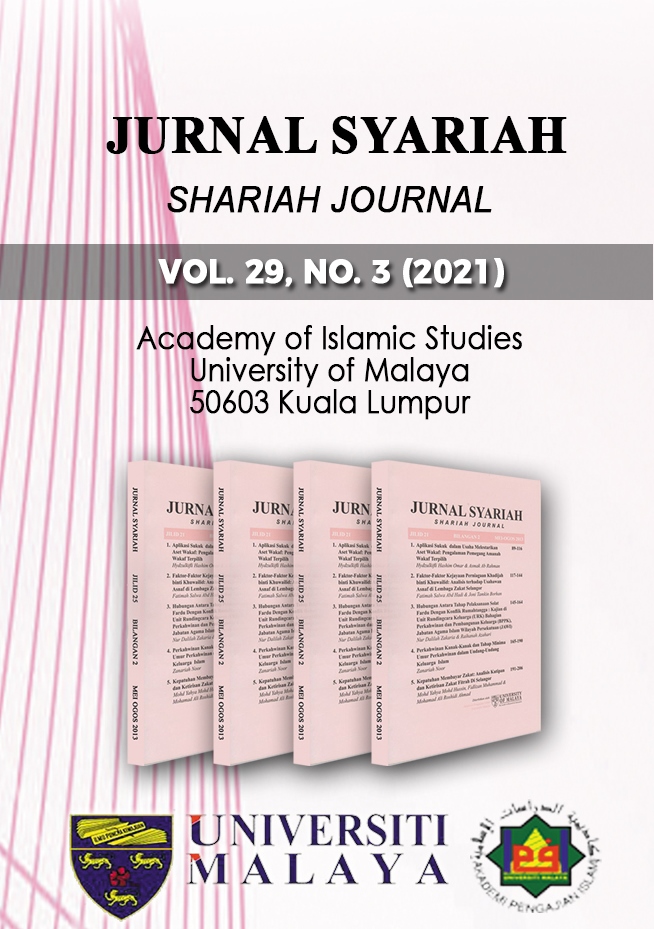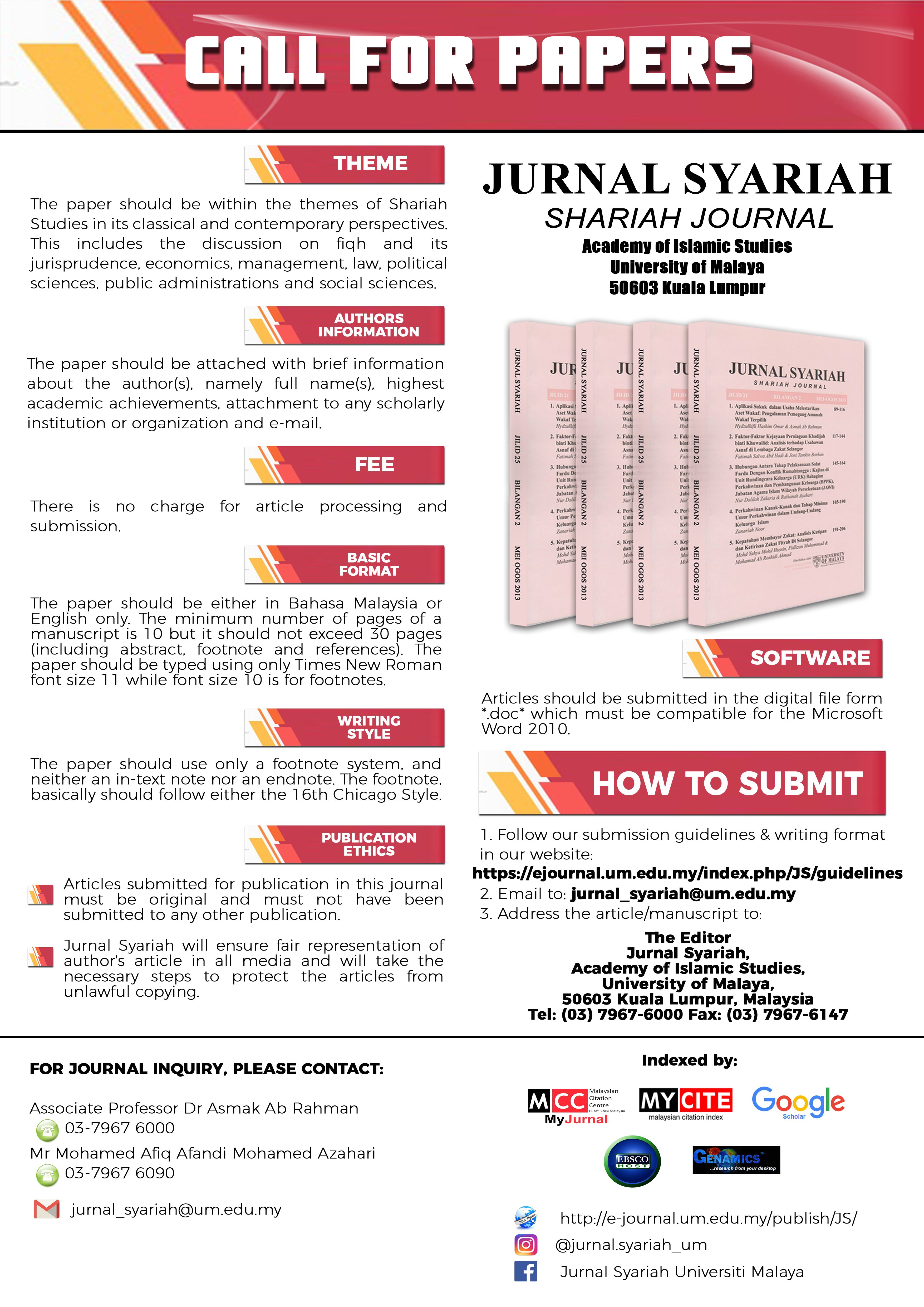KESEJAHTERAAN KELUARGA MENURUT PERSPEKTIF ISLAM: KAJIAN KUALITATIF
Family Wellbeing According to Islamic Perspective: A Qualitative Study
DOI:
https://doi.org/10.22452/syariah.vol29no3.6Keywords:
family, wellbeing, marital satisfaction, religiosity, mithaliAbstract
This study focused on the factors leading to a happily married life. Three married couples who have been awarded mithali and mawaddah family were chosen as samples using purposive sampling method. In depth-structured interviews were conducted to investigate their experience of being happily married and what factors they think are important to be happily married until they are awarded mithali family (until they were given mithali family award). The interview data were then analyzed strictly according to the themes that have been determined along with the evidence from the interviews conducted. Thirteen categories that emerged after coding the data were religiosity, compromise and commitment, marital satisfaction, wise conflict resolution, good communication, presence of children in the marriage, economic status, positivity in the relationship, respect, trust, understanding, lovingness and no mistreatment involved in the relationship. This study has important implications for married couples, counsellors and those directly involved in drafting the Family Wellbeing Index at the Ministry of Women, Family and Community Development.
Downloads
References
Abū Ḥamīd Muḥammad Ibn Muḥammad al-Ghazālī, Khulūq al-Muslim (Riyāḍ: Dār al-Bayān, 1970).
Aḥmad al-Ma‘rūf Bashah Ibn ‘Abd al-Raḥīm al-Dihlawī, Ḥujjah al-Balīghah (Bayrūt: Dār al-Jayl, 2005).
Ahmad Hariri Mohd Saad & Raihanah Hj Azahari, ‘Pengukuhan Institusi Keluarga Melalui Kawalan Terhadap Perceraian: Analisis Literatur,’ Jurnal Fiqh, vol. 11 (2014): 175-194.
Aseel Al-Ramahi, ‘Sulh: A Crucial Part of Islamic Arbitration,’ Research Paper Series At New York Law School, vol. 12 (2008): 1-23.
Bradbury, Thomas N., ‘Assessing the Four Fundamental Domains of Marriage,’ An Interdisciplinary Journal of Applied Family Studies, vol. 44/4 (1995): 459-468.
Al-Bukhārī, Muḥammad bin Ismā‘īl, Ṣaḥīḥ al-Bukhārī (Qāhirah: Maktabah al-Salāfiyah, 1980).
Fatima, M. & Ajmal, M. A., ‘Happy Marriage: A Qualitative Study,’ Pakistan Journal of Social and Clinical Psychology, vol. 9/2 (2012): 37-42.
Guven, Cahit, Senik, Claudia & Stichnoth, Holger, ‘You can’t be happier than your wife: Happiness Gaps and Divorce,’ Journal of Economic Behavior & Organization, vol. 82/1 (2012): 110-130.
Hasniza Che Noh & Fatimah Yusooff, ‘Corak Komunikasi dalam Keluarga,’ Jurnal Hadhari, vol. 3/2 (2011): 45-62.
Hawkins, Alan & Willoughby, Brian & Doherty, William, ‘Reasons for Divorce and Openness to Marital Reconciliation,’ Journal of Divorce & Remarriage, vol. 53 (2012): 453-463.
Ibn Kathīr, Abū al-Fidā’ Ismā‘īl bin ‘Umar, Tafsīr al-Qur’ān al-‘Aẓīm, vol. 6 (Riyāḍ: Dār al-Ṭaybah, 1999).
Ibn Kathīr, Abū al-Fidā’ Ismā‘īl bin ‘Umar, Tafsīr al-Qur’ān al-‘Aẓīm, vol. 3 (Dimashq: Mu’assasah Qurṭubah al-Turāth, 2000).
Ibn Rushd, Bidāyah al-Mujtahid wa al-Nihāyah al-Muqtaṣid, vol. 2 (Bayrūt: Dār al-Jayl, 1989).
Ibn Taymiyah, Aḥkām al-Zawāj (Bayrūt: Dār al-Kutub al-‘Ilmiyyah, 1988).
Khavari, K.A. & Khavari S.W., Creating Successful Family (London: One World Publication Ltd., 1989).
Krumrei, Elizabeth J., A. Mahoney & K. Pargament, ‘Spiritual Stress and Coping Model of Divorce: A Longitudinal Study,’ Journal of Family Psychology: JFP: Journal of the Division of Family Psychology of the American Psychological Association, vol. 25/6 (2011): 973-985.
Lavner, J. A. & Bradbury, T. N., ‘Why do even satisfied newlyweds eventually go on to divorce?’ Journal of Family Psychology, vol. 26/1 (2010): 1-10.
Ledermann, T., Bodenmann, G., Rudaz, M. & Bradbury, T.N., ‘Stress, Communication, and Marital Quality in Couples,’ Family Relations, vol. 59/2 (2010): 195-206.
Lorraine R. Gay, Geoffrey E. Mills, Peter W. Airasian, Educational Research, Competencies for Analysis and Applications (Boston: Pearson Education, 2009).
Lembaga Penduduk dan Pembangunan Keluarga Negara (LPPKN), ‘Laporan Kajian Indeks Kesejahteraan Keluarga Malaysia 2011, Bahagian Kependudukan,’ http://www.lppkn.gov.my/index.php/2014-04-23-06-10-37/indekskesejahteraan-keluarga/29-laporan-kajian-indeks-kesejahteraan-keluargamalaysia-2011/file.html, dicapai pada 20 Mei 2017.
Mahmood Zuhdi Ab Majid, Pengantar Undang-Undang Islam di Malaysia (Kuala Lumpur: Universiti Malaya, 1997).
Maksuda Akter & Roquia Begum, ‘Factors for Divorce of Women Undergoing Divorce in Bangladesh,’ Journal of Divorce & Remarriage, vol. 53/8 (2012): 639-651.
Mariam Majid & Mohammad Syafirul, ‘Perceraian Rumah Tangga di Negeri Selangor Darul Ehsan dan Pendekatan Menanganinya,’ Jurnal Penyelidikan dan Inovasi, vol. 4/2 (2017), 285-303.
Markman, H.J., Rhoades, G.K., Stanley, S.M., Ragan, E.P., & Whitton, S.W., ‘The Premarital Communication Roots of Marital Distress and Divorce: The First Five Years of Marriage,’ Journal of Family Psychology, vol. 24/3 (2010): 289-298.
Nur Dalilah Zakaria & Raihanah Azahari, ‘Hubungan Antara Tahap Pelaksanaan Solat Fardu dengan Konflik Rumah Tangga: Kajian di Unit Rundingcara Keluarga (URK) Bahagian Perkahwinan dan Pembangunan Keluarga (BPPK), Jabatan Agama Islam Wilayah Persekutuan (JAWI),’ Jurnal Syariah, vol. 21/2 (2019): 145-164.
Nur Zahidah Hj Jaapar & Raihanah Hj Azahari, ‘Model Keluarga Bahagia Menurut Islam,’ Jurnal Fiqh, vol. 8 (2011): 25-44.
Patton, M. Q., Qualitative Evaluation and Research Methods, 2nd ed. (Newbury Park, CA: Sage Publications, Inc., 1990).
Polomeno, Viola, ‘Marriage, Parenthood, and Divorce: Understanding the Past as We Move into the Future,’ International Journal of Childbirth Education, vol. 22/3 (2007): 13-19.
Raihanah Azahari, Sulh dalam Kes Kekeluargaan (Kuala Lumpur: Penerbit Universiti Malaya, 2008).
Riggio, H. R. & Weiser, D. A., ‘Attitudes toward Marriage: Embeddedness and Outcomes in Personal Relationships,’ Personal Relationships, vol. 15/1 (2008): 123-140.
Siti Halimah Putung & Raihanah Azahari, ‘Kepemimpinan Suami dalam Perspektif Islam: Fungsi dalam Memperkukuhkan Institusi Keluarga,’ Jurnal Syariah, vol. 28/2 (2020): 127-156.
Siti Marziah Zakaria, Raihlah Bahagia (Selangor: Dasar Cetak (M) Sdn Bhd, 2011).
Steven J. Taylor, Robert Bogdan, Introduction to Qualitative Research Methods: The Search for Meanings, 2nd ed. (Toronto: John Wiley & Sons., 1984).
Sullivan, K. T., ‘Understanding the Relationship between Religiosity and Marriage: An Investigation of the Immediate and Longitudinal Effects of Religiosity on Newlywed Couples,’ Journal of Family Psychology: JFP: Journal of the Division of Family Psychology of the American Psychological Association, vol. 15/4 (2001): 610-626.
Syed Muhammad Naquib al-Attas, Ḥaqīqah al-Sa‘adah wa Ma‘naha fī al-Islām (Kuala Lumpur: International Institute of Islamic Thought and Civilization, 1995).
V. William Harris, Linda Skogrand & Daniel Hatch, ‘Role of Friendship, Trust, and Love in Strong Latino Marriages,’ Marriage & Family Review, vol. 44/4 (2008): 455-488.
Wauterickx, Naomi & Gouwy, Anneleen & Bracke, Piet, ‘Parental Divorce and Depression,’ Journal of Divorce & Remarriage, vol. 45 (2006): 43-68.
Wolcott, Ilene, ‘Strong Families and Satisfying Marriages: A Review of the Literature,’ Family Matters, vol. 53, Winter (1999): 21-30.
Downloads
Published
How to Cite
Issue
Section
License

This work is licensed under a Creative Commons Attribution-NonCommercial 4.0 International License.
COPYRIGHT: All rights reserved. Not allowed to be reproduced any part of articles and contents of this journal in any form or by any way, whether electronic, mechanical, photocopying, recording or otherwise without permission in writing from the Chief Editor, Jurnal Syariah.



















